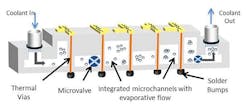Industry to receive details of plan to demonstrate advanced cooling for embedded computing
ARLINGTON, Va., 23 Jan. 2013. U.S. military researchers plan to brief industry on a project to demonstrate advanced electronics cooling techniques for RF monolithic microwave integrated circuit (MMIC) power amplifiers and high performance embedded computer modules that would design convective or evaporative microfluidic cooling directly into the electronic devices and packaging.
Scientists at the U.S. Defense Advanced Research Projects Agency (DARPA) in Arlington, Va., will release details to industry on 7 Feb. 2013 about the second phase of the Intrachip/Interchip Enhanced Cooling (ICECool) program, which seeks to apply intrachip and interchip microfluidic cooling and on-chip thermal interconnects to RF MMICs and powerful embedded computing boards.
DARPA released a broad agency announcement (DARPA-BAA-12-50) last summer for the first phase of the ICECool program, called ICECool Fundamentals, which is exploring revolutionary thermal-management technologies for military electronics to help designers make substantial reductions in size, weight, and power consumption (SWaP).
The 7 Feb. briefings concern the ICECool Applications program. DARPA officials say they expect to release a BAA for the ICECool Applications program sometime before the 7 Feb. briefings, which will be at the Westin Arlington Gateway Hotel at 801 N. Glebe Road in Arlington, Va.
Briefings will include an ICECool vision presentation by Dr. Avram Bar-Cohen, the DARPA ICECool Applications program manager, brief presentations by academic and industry teams on current and planned embedded cooling efforts, and advice on responding to DARPA solicitations. Individual meetings with Bar-Cohen will be available.
The goal of the ICECool Applications program is to enhance the performance of defense electronics by removing one kilowatt per square centimeter heat flux, as well as one kilowatt per cubic centimeter heat density in RF MMICs and high-performance embedded computing boards.
Essentially, DARPA scientists want to make cooling just as important as any other aspect of chip design, and use embedded thermal management to enhance the performance of military electronics. Integrating chips with convective or evaporative microfluidic cooling, DARPA officials say, has the potential to speed the evolution of advanced chip integration.
One fundamental problem that electronic systems designers have today is the large size and weight of cooling subsystems. Ever-smaller chip geometries generate increasing amounts of heat, and the ability to cool electronics is moving more slowly than the ability to shrink chip densities.
This causes some advanced electronics to perform well below the inherent electrical limits of the device technology. Integrating cooling directly into the chip could transform electronic systems architectures and overcome the SWaP bottleneck in advanced electronics, DARPA officials say.
Those interested in attending the ICECool Applications briefings should register online at https://safe.sysplan.com/confsys/icecool/index.html. Attendance costs $90.
E-mail questions or concerns to DARPA at [email protected] with "ICECool Applications Proposers Day" in the subject line.
More information is online at https://www.fbo.gov/spg/ODA/DARPA/CMO/DARPA-SN-13-17/listing.html.

